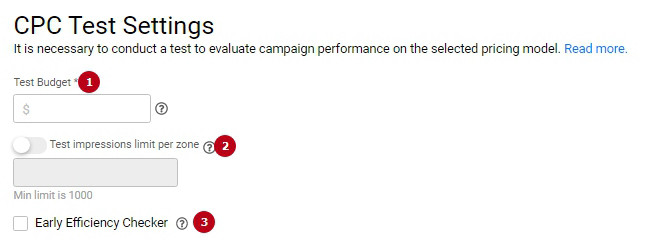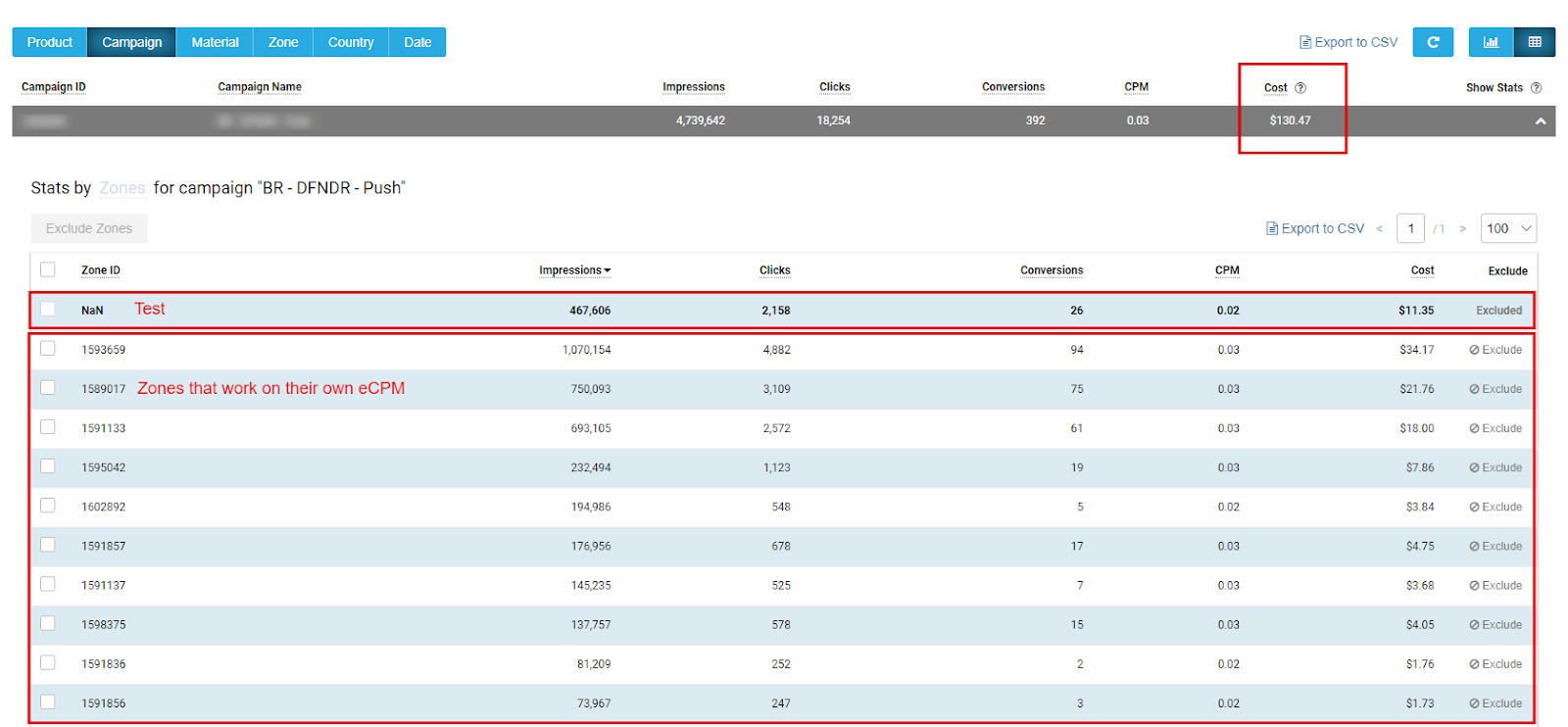To start working with a CPC pricing model, you need to evaluate/measure the effectiveness of your campaign/offer first. In order to do this, a campaign must complete a ‘Testing Period’.
Please note: A minimum click cost (CPC) for all GEOs is $0.001.
Test settings

Test budget
The testing budget refers to a number of funds that will be deducted from your campaign’s budget if the overall cost of produced clicks will not cover the expenses of the tested traffic.
There is no universal answer. We recommend setting your test budget in accordance with an amount that is usually, based on your experience, to estimate your campaign’s/offer’s performance.
However, you should always take into account available volumes of traffic on specific GEOs. If selected geo has got a huge volume of traffic (for example, IN, PK, BR), then it is better to set a higher test budget to be able to test more zones and, thus, get more traffic.
If selected geo has a low traffic volume, then it is advisable to set a smaller test budget. Otherwise, a Testing Period may last for several days.
Please note: the minimum test budget for the CPC campaign is $5.
Test impressions limit per zone
This option will exclude zones that do not bring a single click, after a certain number of impressions has been sent to it, from a campaign’s rotation. This will prevent you from buying unnecessary traffic that does not show good results with your offer.
Early Efficiency Checker
This option checks the efficiency of your campaign in its early stages. So, in case your campaign has low performance, this option can stop a test before it is completed to prevent the loss of your test budget.
It may be very helpful in case you want to test several offers or landing pages at the same time, and you do not want to pay for their test budgets in full multiple times. Campaigns that have shown a low performance will be stopped in the very beginning, and your funds will be saved.
Note that ‘Early Efficiency Checker’ may end your campaign’s test prematurely, and a result may turn out to be ‘Failed’. Use this option carefully if you are acquainted with your offer well.
What is a test?
To evaluate the effectiveness of a campaign, it is necessary to send a certain amount of traffic to an offer and measure its early results. You have to set a test budget, which will be used to buy traffic for evaluation. A special algorithm will be applied to calculate an optimal bid for each specific zone.
Tests could be free and compensated.
If the overall cost of received clicks covers, or is higher than, the expenses of the tested traffic, then a test is considered free since you are only paying for clicks.
If the overall cost of received clicks does not cover or is not greater than, expenses of the tested traffic, the difference is compensated from the test budget. Such tests are called compensated.
For instance, we have “Campaign A” and “Campaign B”.
Campaign A – free test
The testing budget is set to $10. This means that a campaign has received an amount of traffic worth of $10 during the test.
Click cost (CPC rate) is $0.5.
Number of clicks is 25.
Thus, the overall cost of produced clicks is $0.5 * 25 = $12.5.
The overall cost of produced clicks $12.5 > (is greater than) Traffic cost $10.
As we can see, the overall cost of produced clicks has fully covered the traffic cost, which was spent on the test. This way, you pay only for clicks.
Campaign B - Compensated Test
The testing budget is $10. So, accordingly, a campaign has received an amount of traffic worth $10 during the test.
Click cost (CPC rate) is $0.25.
Number of clicks is 20.
Thus, the overall cost of producing clicks $0.25 * 20 = $5.
The overall cost of produced clicks $5 < (is less than) Traffic cost $10.
As we can see, the overall cost of produced clicks is not enough to cover the traffic cost used for the test. Therefore, the system compensates for traffic costs from the test budget.
So, a traffic cost is calculated in this way:
$10 (Test Budget) = $5 (Overall cost of produced clicks) + $5 (Traffic cost).
In this case, you pay both for clicks and for the traffic used for the test.
The bigger the test budget, the more traffic a campaign will receive during its test, and, thus, more zones will be tested.
Testing zones/traffic sources
Now let’s take a look at what happens to the zones during and after a test.
Smart campaigns have a self-optimization function. "Set impression limit by zone" section allows you to receive an appropriate amount of impressions from a specific zone in case it does not produce any clicks. This option excludes zones from a test that don’t provide a single click after a fixed volume of impressions has been received from it. This will prevent you from buying unnecessary traffic that does not show good results with your offer.
The main purpose of the test is to determine traffic zones that produce more clicks. The zones with clicks are the most lucrative, and we want to get more traffic from them. Let’s take a close look at what happens when a good zone is found during a test. After a zone has produced some clicks, the system forms an eCPM for this zone and continues to buy traffic on it according to this very eCPM. From now on, the needed traffic is purchased both as a part of the test and out of it (independently).
On the Dashboard, you can see what the current test cost is, as well as separate costs for the zones that work according to their own eCPM. For this reason, you may see the campaign that is in the test with a cost that exceeds a previously set test budget.

eCPM calculation example
eCPM = (Click cost * Total number of Clicks / Traffic volume) * 1000
For example:
Click cost = $0.5.
Total number of Clicks = 10
Traffic received = 10 000
eCPM = ($0.5 * 10/10 000) * 1000 = $0.5
End of a test period and its results
A test is considered complete when a campaign has received the volume of traffic worth the defined test budget. After that, the system will evaluate the test results according to internal metrics and assign a specific status to a test. A test status will determine how a campaign will function in the future.
Test statuses:
- Failed - there were either no clicks at all received, or their overall cost did not form a sufficient CPM to work further as a part of a campaign. Such campaigns are stopped automatically after its test has finished.
Possible reasons for ‘Failed’ status:
- Low click cost (try increasing your click cost);
- Low CTR (try using another creative).
- Not so good - a campaign has shown some good results during its test. But this campaign is still not good enough to work on all zones (RON). In this case, the campaign’s CPM will quickly decrease, and then it will stop receiving traffic (even though it will be technically ‘Working’). With this status, a campaign will only work within the zones where clicks were received during the testing period.
Possible reasons for ‘Not so good’ status:
- Low click cost (try increasing your click cost);
- Low CTR (try using a more appealing creative);
- Insufficient test budget (only a few zones were tested - try increasing your test budget next time you run this campaign).
- Succeeded - a campaign has shown excellent results, and will work on all zones (RON) and receive more traffic. This status is given to campaigns where a test was considered free. Moreover, this status is assigned to campaigns with a compensated test, seeing as the system relies on various metrics and can predict the potential success of a campaign.
The duration of the testing period depends on a test budget that you set, and the volume of traffic on a chosen. A test can last from several minutes to several hours on GEOs with huge traffic volume, and from several hours to several days on GEOs with a low volume of traffic. Please also note that the more specific the targeting of your campaign is, the longer its test will last.
What is the testing period for? Can I run my campaigns on pure CPC?
- Campaign optimization during a test;
Zones with low performance are automatically excluded from a campaign’s rotation during the test and from the campaign in general. It also helps to form blacklists for future tests/campaigns.
- To determine a suitable traffic zone and purchase from them;
A campaign purchases more traffic from zones that have received more clicks in the past.
- The main purpose of the testing period is to form an eCPM for a campaign, according to which relevant traffic is to be purchased in the system.
While your campaign is in the testing period, you cannot change its targeting settings, but click cost.
If your active campaign’s targeting is modified in any way, it will be sent for moderation once again. However, if you decide to change its click cost, your campaign will carry on working (or being tested).